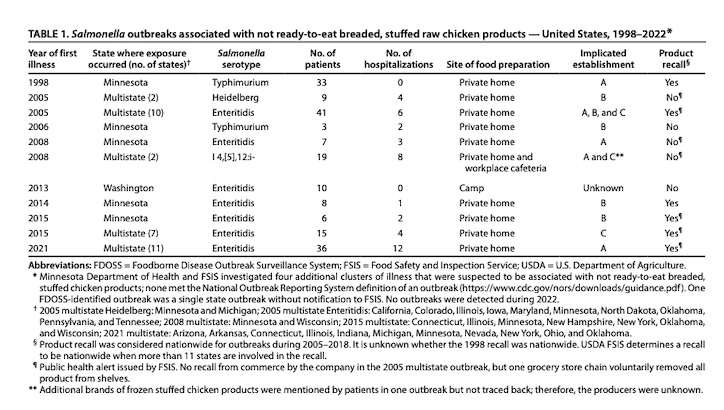The CDC says the USDA’s plan to make Salmonella in stuffed, breaded chicken products an adulterant will improve public health. In a new report, the Centers for Disease Control and Prevention (CDC) chronicles the public health toll these products have taken. Between 1998 and 2022, 11 Salmonella outbreaks were linked to not-ready-to-eat (NRTE), frozen, breaded, stuffed chicken products such as chicken Kiev and chicken Cordon Bleu. These outbreaks sickened 187 people, hospitalizing 42 of them.

Labeling Changes Haven’t Worked
Most of the products associated with these outbreaks, which were produced “by at least three establishments,” were found to contain Salmonella when tested. Over the years, labeling changes have been made to better alert customers that these products are raw even though the breadcrumb coating makes them appear to be cooked. However, these changes have not stopped outbreaks from occurring. “Thus, stronger controls are needed to prevent illnesses associated with these products,” the report states.
Performance Standard for Chicken Used to Make These Products
These products are often made from trimmings or comminuted chicken. The U.s. Department of Agriculture’s Food Safety and Inspection Service (USDA FSIS) has performance standards, or allowable levels of Salmonella, for various kinds of poultry. Comminuted chicken has the highest allowable percentage, 25 percent of samples tested.
Many Illnesses Have Likely Gone Undetected
The Minnesota Department of Health (MDH) identified all multistate outbreaks, and almost half of outbreaks had cases identified only in Minnesota, the report states. This suggests that other outbreaks occurred but were not identified in other states.
USDA Action
USDA FSIS plans to declare Salmonella in these chicken products an adulterant. That means products containing even a small amount of Salmonella will not be allowed to enter commerce. Because of the high rate of contamination, and the lack of reporting in states other than Minnesota, this action will reduce Salmonella illnesses and encourage the makers of these products to better control Salmonella levels, CDC report concludes.
